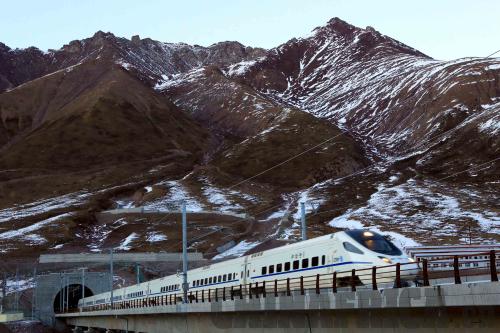|

Exports of China's high-speed rail machinery rise sharply in 2014
Roadblocks ahead
China's GDP hit $10.4 trillion in 2014, almost twice that of Japan, making it the second country with GDP surpassing $10 trillion. "Despite that, the per-capita GDP was roughly $7,400, ranking around 80th among all the countries on the globe," said Lin Caiyi, chief economist of Guotai Jun'an Securities.
China is still a middle-income country and has to overcome the so-called "middle-income trap" - an economic development situation where a country attaining a certain income gets stuck there. It should stimulate market vigor through innovation, transformation and opening up, Lin observed.
Zhang Qizuo, Deputy Secretary General of Globalization Cooperation Forum, held that the economy cannot sustain over-investment in manufacturing, real estate and infrastructure construction. It would only aggravate overcapacity, housing bubbles, local government debt and financial risks.
Due to the adjustment of the real estate market and the reduction of overcapacity in the manufacturing industry in recent years, the growth of fixed assets investment has been slowing down. Last year, it registered only 15.1-percent growth. Since investment in the manufacturing industry accounted for over 30 percent of the total, eliminating overcapacity and curbing overlapping investment will inevitably result in lower growth of fixed assets investment, said Ma. China's economy, the official added, faced great downward pressures in 2014 and would do so in 2015 too.
When adjusting economic structure and dealing with excess production capacity, traditional manufacturing enterprises are more likely to suffer capital chain ruptures, which will activate default risks and generate bad loans, said Lin.
"Generally speaking, when economic growth slows down, the leverage ratio will ascend. Surging leverage ratio reflects enterprises' dwindling capacity to pay off debts," said Yu.
As an important economic parameter, China's CPI grew a mere 2 percent in 2014. By the end of December, the producer price index (PPI) had seen negative growth for 34 consecutive months, according to NBS statistics.
Lian Ping, chief economist at the Bank of Communications, noted that the consecutive negative PPI growth has constrained the expansion of the manufacturing industry and undermined the development of the macro-economy.
The decline of CPI and PPI mirrors weak domestic demand; the risk of deflation will stretch the endurance of China's economy, said HSBC's Qu.
"Since the second half of 2014, the prices of international bulk commodities like crude oil have plunged, which will increase the possibility of deflation," Qu warned.
Macro-economic Indicators in 2014
» Consumer price index, the main gauge of inflation, rose 2 percent.
» Producer price index, which measures inflation at the wholesale level, contracted 2.2 percent.
» Foreign trade increased 3.4 percent to $4.3 trillion. Exports increased 6.1 percent to $2.34 trillion, while imports increased 0.4 percent to $1.96 trillion.
» Inward foreign direct investment (FDI) on the Chinese mainland stood at $119.56 billion, up 1.7 percent.
» Outward FDI from the Chinese mainland stood at $102.89 billion, up 14.1 percent.
» Value-added output of industrial enterprises above a designated size - with principal business revenue of more than 20 million yuan ($3.22 million) a year - grew 8.3 percent.
» Fixed assets investment totaled 50.2 trillion yuan ($8.09 trillion), up 15.1 percent with inflation deducted.
» Retail sales totaled 26.24 trillion yuan ($4.23 trillion), up 10.9 percent with inflation deducted.
» Per-capita disposable income of urban residents stood at 28,844 yuan ($4,646), up 6.8 percent with inflation deducted.
» Per-capita cash income of rural residents stood at 10,489 yuan ($1,689), up 9.2 percent with inflation deducted.
» New yuan-denominated loans totaled 9.78 trillion yuan ($1.58 trillion), 890 billion yuan ($143.34 billion) more than in 2013.
» As of the end of 2014, M2, a broad measure of money supply that covers cash in circulation and all deposits, reached 122.84 trillion yuan ($19.78 trillion), up 12.2 percent.
(Sources: National Bureau of Statistics, Ministry of Commerce)
|